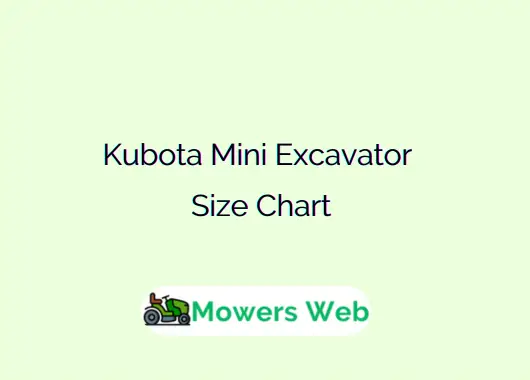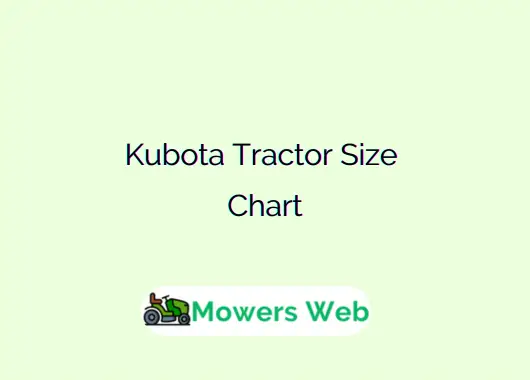Kubota mini excavators are used in construction, landscaping, utilities, and agriculture. Choosing the right model depends on size, digging depth, weight, and power requirements.
Below is a comprehensive Kubota mini excavator size chart covering most models available today. This table helps you compare specifications and select the perfect excavator for your job.
Kubota Mini Excavator Size Chart
| Model | Engine Power (hp) | Operating Weight (lbs) | Max Dig Depth (ft/in) | Width (ft/in) | Tail Swing Type |
|---|---|---|---|---|---|
| K008-5 | 10.3 | 2,315 | 5’8” | 2’10” | Conventional |
| U10-5 | 10.3 | 2,646 | 5’11” | 3’3” | Zero Tail Swing |
| U15-3 | 13 | 3,395 | 7’6” | 3’3” | Zero Tail Swing |
| U17 | 16.1 | 3,693 | 7’7” | 3’3” | Zero Tail Swing |
| KX018-4 | 15.5 | 3,747 | 7’10” | 4’3” | Conventional |
| KX019-4 | 16 | 4,090 | 7’11” | 4’3” | Conventional |
| U20-3S | 19.8 | 5,625 | 8’4” | 4’11” | Zero Tail Swing |
| U25-3 | 20.9 | 5,602 | 8’5” | 4’11” | Zero Tail Swing |
| U27-4 | 20.9 | 5,668 | 9’5” | 4’11” | Zero Tail Swing |
| KX027-4 | 24.0 | 5,908 | 9’4” | 5’0” | Conventional |
| KX030-4 | 24.7 | 6,272 | 9’7” | 5’1” | Conventional |
| KX033-4 | 24.8 | 7,420 | 10’6” | 5’1” | Conventional |
| U35-4 | 24.8 | 8,488 | 9’9” | 5’7” | Zero Tail Swing |
| U36-4 | 23.9 | 8,200 | 9’9” | 5’7” | Zero Tail Swing |
| KX040-4 | 40.4 | 9,195 | 11’3” | 5’7” | Conventional |
| U48-5 | 40.4 | 10,848 | 10’8” | 6’5” | Zero Tail Swing |
| U55-5 | 47.6 | 12,247 | 11’11” | 6’5” | Zero Tail Swing |
| KX057-5 | 47.6 | 12,346 | 12’9” | 6’5” | Conventional |
| KX060-5 | 47.6 | 13,260 | 12’10” | 6’7” | Conventional |
| KX080-4S2 | 66.6 | 18,596 | 15’1” | 7’3” | Conventional |
| KX080-5 | 66.6 | 18,760 | 15’1” | 7’3” | Conventional |
Related Kubota Tire Size Chart(For All Series + Models)
Understanding the Kubota Mini Excavator Series
Kubota’s mini excavator lineup is divided mainly into KX and U series:
- KX Series: Standard tail swing models offering higher digging force and stability.
- U Series: Zero tail swing models ideal for tight spaces and urban environments.
Each series includes multiple models to meet different job requirements. Let’s explore how to interpret the specifications in the chart.
1. Engine Power
Engine power determines how much work the excavator can perform efficiently. Smaller models like the K008-5 and U10-5 with around 10 horsepower are suitable for light landscaping, trenching, and utility work. Mid-range excavators like the KX030-4 and U35-4 deliver around 23-24 horsepower, ideal for construction and small commercial jobs. Heavy-duty models like the KX080-5 with 62 horsepower handle larger excavation and site preparation tasks.
2. Operating Weight
Operating weight affects stability, transport requirements, and ground pressure.
- Lightweight (under 2 tons): Easier to transport and maneuver; perfect for confined spaces.
- Medium (2–5 tons): Balanced performance for most general-purpose jobs.
- Heavy mini (5–8+ tons): Higher lifting capacity and deeper digging, suited for demanding worksites.
For instance, the U17 weighs only 3,693 lbs and fits through narrow gates, while the KX080-5 weighs 18,760 lbs and can handle deep excavation and heavy lifting.
Related Kubota Tractor Size Chart(For Series + Models)
3. Digging Depth
Maximum dig depth determines how deep you can excavate safely. A compact model like the K008-5 digs about 5 feet 8 inches deep, suitable for shallow trenches. Mid-range models like the KX030-4 reach around 9 feet 7 inches, while the KX080-4S2 digs over 15 feet deep, ideal for foundation and utility work.
4. Width and Tail Swing
Machine width is crucial when working in restricted spaces or indoors.
- Narrow machines (under 4 feet): Ideal for backyards and interior demolition.
- Medium width (4–6 feet): Good compromise between stability and accessibility.
- Wide (over 6 feet): More stable for large outdoor projects.
The tail swing type determines how much the rear of the excavator extends beyond its tracks. Zero Tail Swing (U-Series) models prevent collisions in tight spots, while Conventional Tail Swing (KX-Series) models offer better lift and balance.
Related John Deere Tractor Dashboard Symbols(ALL + Meanings)
Choosing the Right Kubota Mini Excavator
When selecting a Kubota mini excavator, consider the following:
1. Job Site Space:
- Tight areas → U10-5, U17, U27-4
- Open areas → KX040-4, KX057-5
2. Digging Needs:
- Shallow landscaping → K008-5, U10-5
- Medium trenching → U35-4, KX030-4
- Deep excavation → KX080-4S2, KX080-5
3. Transport:
- Under 4,000 lbs can be towed on smaller trailers.
- Over 10,000 lbs typically requires larger trucks and permits.
4. Attachments:
- Kubota mini excavators support buckets, augers, breakers, and thumbs.
- More powerful models can handle a wider range of hydraulic tools.
Related Lawn mower Oil Capacity Calculator
Benefits of Kubota Mini Excavators
- Fuel Efficiency: Kubota engines are known for low fuel consumption.
- Operator Comfort: Spacious cabs and ergonomic controls reduce fatigue.
- Ease of Maintenance: Simplified engine access and fewer maintenance points.
- Reliability: Kubota’s long-standing reputation ensures long-term dependability.
Final words
Kubota’s mini excavator lineup covers a wide range of sizes, from the ultra-compact K008-5 to the robust KX080-5. Whether you’re a contractor, landscaper, or equipment rental operator, the chart above makes it easy to compare specifications and choose the right model for your needs.
Smaller models are perfect for confined workspaces, while the larger models deliver the power and depth required for heavy-duty construction. With a reputation for reliability, fuel efficiency, and smooth operation, Kubota remains a top choice in the mini excavator category worldwide.




